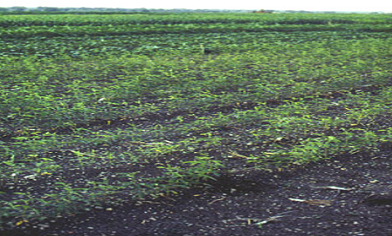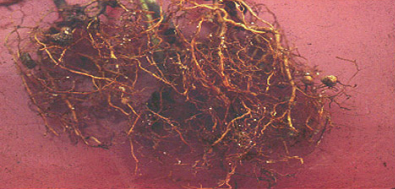Nematodes - pigeonpea
Contributors to this page: ICRISAT, Patancheru, India (RP Thakur, AG Girish, VP Rao).
 Pearly root (Heterodera cajani) of pigeonpea symptoms in field (photo: ICRISAT). |
Pearly root
Scientific name
Heterodera cajani Koshy.
Other scientific name
Heterodera vigni.
Importance
Low.
Significance
Yield losses of over 30% and 28% reduction in plant growth have been reported (Sharma et al. 1993).
Symptoms
Heterodera cajaniis primarily a root-parasite. The most important characteristic symptom is the presence of cysts on the root surface. Identification of "pearly root" caused by the presence of white females is a useful symptom of H. cajani infestation in pigeon pea at the vegetative stage (Sharma 1993). The symptoms of nematode injury include stunting, reduced leaf lamina size and yellowing on cotyledonary leaves (Gaur and Singh 1977). Flowers and pods are reduced in size and number and the root system may also be poorly developed. Foliage symptoms are generally not apparent even in heavily infested soils, but a reduction in height and vigor of the infected plants can be discerned by careful comparison with healthy plants.
 Root damage symptoms of pearly root of pigeonpea |
Hosts
Cajanus cajan (pigeon pea), Cyamopsis tetragonoloba (cluster bean), Lablab purpureus (hyachinth bean), Vigna aconitifolia (aconite-leaved kidney beans), Vigna radiata (bean, mung), Vigna mungo (black gram), Phaseolus vulgaris (common bean), Pisum sativum (pea), Sesamum indicum (sesame) and Vigna unguiculata (cowpea) (Sharma and Nene 1985).
Geographic distribution
Heterodera cajani has been reported from Egypt, India and Pakistan. It is wide spread in sandy-loam soils in northern India and in black cotton soils in western and southern India (Reddy et al. 1993; Varaprasad et al. 1997).
Biology and transmission
The adult females are lemon-shaped and sedentary in habit, and remain attached to roots semi-endoparasitically. These are white to slightly brown, with a neck and posterior cone-like elevation on which the vulva is situated; turns into a cyst of same size and shape. Posterior part of body protruding outside the root usually appears with small rounded egg sac attached to it. Cephalic region has two annules; the second is larger than the first. Stylet is of medium strength, in two equal parts; basal knobs round to slightly anteriorly flattened. Median esophageal bulb large rounded, with well developed valve plates. The excretory pore is placed posterior behind the median bulb. Oesophageal glands extend over the intestine. Ovaries are paired and convoluted. Uterus with several eggs filling most of the body. Vulva is a large transverse slit on a cone-shaped elevation of the body. Anus is close to vulva. An egg sac is present. The size of egg sacs varies between 0.5-2 times the sizes of cyst. Egg sacs are yellow, occasionally purple. Few to 200 eggs (average 54) are found in the egg sacs (Koshy and Swarup 1971). Eggs may be retained inside the female body but many are laid in a gelatinous matrix forming egg sacs. Eggs are oval, 95-115 µm long, and 37-48 µm wide. Eggshell is hyaline, without surface markings. Morphological characteristics of 2nd-, 3rd- and 4th-stage juveniles of H. cajani, H. avenae and H. mothi are described and compared by Taya and Bajaj (1986). Males are vermiform.
Detection/indexing methods at ICRISAT
- Pre-export field inspection.
Treatment/control
- Not available.
Procedures followed in case of positive test at ICRISAT
- Rejection of the seed samples.
References and further reading
Gaur HS, Singh I. 1977. Pigeon-pea cyst nematode, Heterodera cajani, associated with the moong crop in the Punjab State. Journal of Research, Punjab Agricultural University 14: 509.
Koshy PK, Swarup G. 1971. Investigations on the life history of the pigeon-pea cyst nematode, Heterodera cajani. Indian Journal of Nematology 1:44-51.
Reddy MV, Raju TN, Sharma SB, Nene YL, McDonald D. 1993. Handbook of pigeonpea diseases. Information bulletin no. 42. Patancheru, AP, 502324, India: International Crops Research Institute for the Semi-Arid Tropics. 64pp.
Sharma SB. 1993. Pearly root of pigeonpeas caused by Heterodera cajani. Indian Journal of Nematology 21: 169.
Sharma SB, Nene YL. 1985. Additions to host range of pigeonpea cyst nematode, Heterodera cajani. International Pigeonpea Newsletter 4: 42.
Sharma SB, Nene YL, Reddy MV, McDonald D. 1993. Effect of Heterodera cajani on biomass and grain yield of pigeon pea on vertisol in pot and field experiments. Plant Pathology 42: 163-167.
Taya AS, Bajaj HK. 1986. Larval stages of Heterodera avenae Woll, H. cajani Koshy and H. mothi Khan and Husain. Indian Journal of Nematology 16: 160-162.
Varaprasad KS, Sharma SB, Loknathan TR. 1997. Nematode constraints to pigeonpea and chickpea in Vidarbha region of Maharashtra in India. International Journal of Nematology 7: 152-157.
Comments
- No comments found

Leave your comments
Post comment as a guest